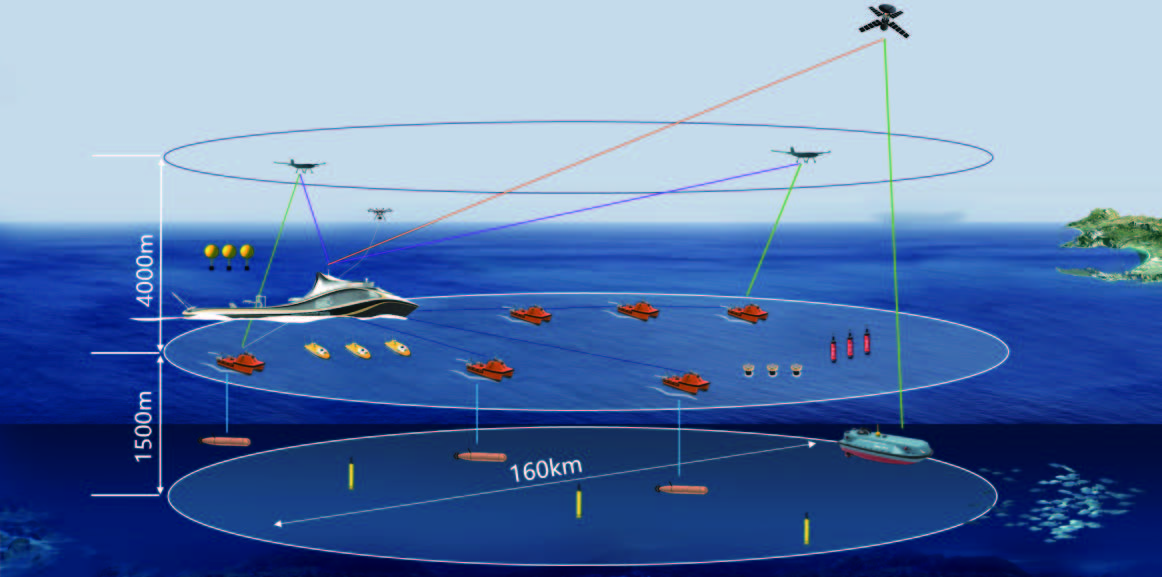
A schematic of ISOOS.
CREDIT: W. Xu, J. L. Li, Y. P. Li, H. F. Chen, S. Q. Yang, J. B. Zeng, Y. H. Wang. Networks of Unmanned Underwater Vehicles for Ocean Exploration: Advances and Prospects. Science and Technology Foresight, 2022, 1(2): 60-78.
Taking advantage of the innovations in automated machinery, researchers are using autonomous and unmanned technologies to explore the deep blue sea
The ocean has always been a force to be reckoned with when it comes to understanding and traversing its seemingly limitless blue waters. Past innovations such as deep-sea submersibles and ocean-observing satellites have helped illuminate some wonders of the ocean though many questions still remain. These questions are closer to being answered thanks to the development of the Intelligent Swift Ocean Observing System (ISOOS). Using this system, targeted regions of the ocean can be mapped in a three-dimensional method allowing for more data to be gathered in a safer, quicker and more efficient method than existing technologies can achieve.
Researchers published their results in Ocean-Land-Atmosphere Research on Sep. 9, 2023.
“The basic idea is, using a smart carrier as the mobile system base and control center, to build a cross-domain network of several tens of UAVs [unmanned aerial vehicles], USVs [unmanned surface vessels] and AUVs [autonomous underwater vehicles] for fast, simultaneous, 3-dimensional observation of any targeted regions,” said Chao Dong, researcher and author of the study.
This “crew” of unmanned vessels and vehicles is on-trend with the innovations being made in intelligent autonomous machines which are attractive thanks to their adaptability and flexibility, to name just a couple of qualities. Notably, ISOOS can be key in understanding the role of submesoscale eddies, which are essentially circular currents of water that go against the general ocean current (whirlpools) and happen to be less than 100 kilometers wide. There is not much known about these eddies right now since they are subject to high variability in space and time. Therefore, a fast scan in the areas they tend to occur can do much more for understanding their occurrences and role in global ocean dynamics than is possible now with existing methods.
Another feat that ISOOS can achieve is ocean floor mapping. Typically this is very time-consuming and expensive, but with the concerted efforts of USVs and AUVs the efficiency in mapping the ocean floor can be increased significantly. For example, a notable recent attempt using AUVs and USVs was the search for the suspected crash of flight MH370. Though no indications of wreckage were found, using the AUVs and USVs 125,000 square kilometers (or 48,262 square miles) of the sea floor was mapped in just under 5 months.
“In the future, we will try to use ISOOS fulfilling the tasks that are either impossible to approach or inefficient to complete with any existing technologies,” said Dake Chen, corresponding author and researcher.
ISOOS opens up many more avenues of exploration and scientific research when humans do not have to directly be involved in manning the crafts, and instead can be operating or observing the missions remotely. The coordinated efforts of vessels and vehicles used in ISOOS can save countless hours of effort, materials, costs and hardship.
ISOOS also has the potential to be used for searching for wreckage from ships or aircraft, as well as capturing time and space-sensitive oceanic phenomena that would otherwise remain unstudied if traditional methods were employed.
Original Article: Unmanned and unbothered: autonomous intelligent oceanic exploration is upon us
More from: Sun Yat-sen University | South China University of Technology | Zhejiang University
The Latest Updates from Bing News
Go deeper with Bing News on:
Autonomous intelligent oceanic exploration
- Endless Ocean is a simple, serene swim on the Switch
The best way to experience Endless Ocean Luminous is to just swim. A follow-up to a series of scuba diving games on the Wii, Luminous has a story to play through and goals to accomplish. But they’re ...
- NASA’s Latest Tech Triumphs: AI, Robots & Space Exploration
Explore how NASA's 2024 breakthroughs in AI and robotics are revolutionizing space exploration and Earth monitoring.
- China launches construction of cutting-edge marine research vessel
The vessel will become China's leading scientific research platform in the East China Sea, capable of conducting scientific research and providing engineering support ...
- Nature-Inspired Submarine Glider: Manta Ray to Revolutionize Ocean Missions
Northrop Grumman's Manta Ray uncrewed underwater vehicle (UUV) is pioneering ocean exploration for people and autonomous vehicles. The Advanced Research Projects Agency (DARPA) designed the Manta Ray, ...
- New stealthy submarine glider set for autonomous undersea missions
The ocean depths are a new frontier explored by humans and autonomous vehicles.Leading the charge is Northrop Grumman's innovative Manta Ray uncrewed underwater vehicle (UUV), a technological ...
Go deeper with Bing News on:
Intelligent Swift Ocean Observing System
- The International Date Line Is ‘Pretty Arbitrary.’ Here’s Why.
April 24, 2024 Taylor Swift flies to Las Vegas from Japan ... referring to the Pacific Islands Ocean Observing System, a nonprofit based in Hawaii. So which version is right?
- Intelligent Systems
[The Laboratory of Intelligent Systems], at EPFL in Switzerland designed GimBall to not only take impacts in stride, but to actually use them as navigational aids. This is similar to an insect ...
- Best Intelligent Systems Games
Intelligent Systems excels at creating unique RPG titles with core mechanics replicated by future developers. WarioWare: Twisted! introduced innovative gameplay with gyro sensors and rumble ...
- An intelligent system for a smoother journey
Nine years ago, when Pia Hu was making a long journey from Belgium to Sweden to test a new driving system, she was hoping that her car’s automated and ‘intelligent’ features would provide a ...
- Observing the Solar System
This up-to-date, self-contained guide provides a detailed and wide-ranging background to Solar System astronomy, along with extensive practical advice and resources. Topics covered include: ...










